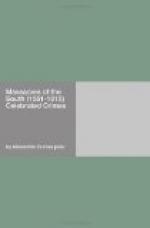In obedience to Cavalier’s orders, the four criminals were taken and brought before him. He was then with his troops near Saint-Maurice de Casevielle; he called a council of war, and having had the prisoners tried for their atrocious deed, he summed up the evidence in as clear a manner as any lawyer could have done, and called upon the judges to pronounce sentence. All the judges agreed that the prisoners should be put to death, but just as the sentence was made known one of the assassins pushed aside the two men who guarded him, and jumping down a rock, disappeared in the forest before any attempt could be made to stop him. The three others were shot.
The Catholics also condemned many to be executed, but the trials conducted by then were far from being as remarkable for honour and justice as was that which we have just described. We may instance the trial of a poor boy of fourteen, the son of a miller of Saint-Christol who had been broken the wheel just a month before. For a moment the judges hesitated to condemn so young a boy to death, but a witness presented himself who testified that the little fellow was employed by the fanatics to strangle Catholic children. Although no one believed the evidence, yet it was seized-on as a pretext: the unfortunate boy was condemned to death, and hanged without mercy an hour later.
A great many people from the parishes devastated by M. de Julien had taken refuge in Aussilargues, in the parish of St. Andre. Driven by hunger and misery, they went beyond the prescribed limits in search of means of subsistence. Planque hearing of this, in his burning zeal for the Catholic faith resolved not to leave such a crime unpunished. He despatched a detachment of soldiers to arrest the culprits: the task was easy, for they were all once more inside the barrier and in their beds. They were seized, brought to St. Andre’s Church and shut in; then, without trial of any kind,—they were taken, five at a time, and massacred: some were shot and some cut down with sword or axe; all were killed without exception—old and young women and children. One of the latter, who had received three shots was still able to raise his head and cry, “Where is father? Why doesn’t he come and take me away.”
Four men and a young girl who had taken refuge in the town of Lasalle, one of the places granted to the houseless villagers as an asylum, asked and received formal permission from the captain of the Soissonais regiment, by name Laplace, to go home on important private business, on condition that they returned the same night. They promised, and in the intention of keeping this promise they all met on their way back at a small farmhouse. Just as they reached it a terrible storm came on. The men were for continuing their way in spite of the weather, but the young girl besought them to wait till daylight, as she did not dare to venture out in the dark during such a storm, and would die of fright if left alone at the farm.




